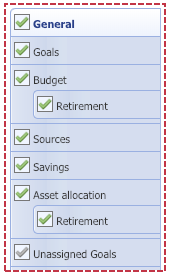How to edit a plan
Comprehensive planning is dynamic, involving periodic reviews with the client to ensure their current goals and aspirations are reflected in their financial plan. The portfolio is inextricably linked to the plan and, as a result, when the plan changes so should the portfolio.
This document walks through the following key steps to update the plan and portfolio:
-
- Goals, savings, sources, asset allocation
- Current account
- Liquidity
Step 1. Clean up any unexecuted transactions (if necessary)
Identify if there are any unexecuted transactions (trades or plans) on the overview page
Unexecuted transactions are identified by a number inside parentheses "(1)”
Click here for steps on how to clean up an unexecuted transaction
If you don't have any unexecuted transactions, go to Step 2

Step 2. Update assets
Manage/review > Update Assets > Update Assets
Go to the Manage/review page (Overview > Manage/review)
Click Update Assets
- Papered Symplany℠ accounts (e.g. IA Account) will automatically populate any new holdings
If the account is not a papered Symplany℠ account, you will need to manually upload your fund holdings.
- Papered Symplany℠ accounts (e.g. IA Account) will automatically populate any new holdings
For external accounts (e.g. Client 401k), you will manually update holdings by clicking in the Holdings column and typing in the updated values.
Click Update Assets

Step 3. Review plan details
It might be helpful to get a quick overview of the client's current situation before making changes.
Go to the Review Plan page (Overview > Manage/review > Review Plan)
Review Goals, Sources, and Savings to better understand the client's current situation and determine what, if any, changes need to be made.

Step 4. Edit the plan
After reviewing the plan details, if you need to make changes:
Click Edit Plan on the Overview page.
Open each of the following pages and review plan details for accuracy.
Update the client's liquidity preferences (if applicable).
Update the client's sweep preferences (if applicable).
Update the client's current account (if applicable).


Step 5. Preview the trade
After updating the plan, you can preview the trades:
Click Trade Preview
- Accounts are listed side-by-side
- The pie chart for each account shows what the new allocation will be after the trade is placed
Additional information on each account can be found under the Info, Buckets and Profile tabs.

Click Preferences to set up the trade:
- There is a green check next to any accounts if assets were updated today
- Information in this first pop-window tends to be static (e.g. Fund template, restrictions, profile location, and current account empty date)
After reviewing these settings, click This looks good

Set your preferences
- Check the boxes for Re-do profile location and Asset rebalance columns to align each account with the updated plan.
- Re-do profile location updates which buckets are held in each account
- Asset rebalance will sell out of overweighted sub-asset classes and buy into underweighted ones, thus minimizing your drift (the bar graphs on the far right)
- Check the Sweep action box to reset it to its target amount
- Under Fund trade preferences, you can click Don't trade, Match allocation, or Match fund template
Don't trade will not allow any trades in that account (you cannot select Don't trade if you are re-doing the profile location, doing an asset rebalance, or rebalancing sweep)
Match allocation will attempt to rebalance the account and work around existing positions, even if they are not on the fund template.
Match fund template liquidates any funds not on your fund template

- Check the boxes for Re-do profile location and Asset rebalance columns to align each account with the updated plan.
Click Calculate when you have finished setting preferences.
The Trades column will display the number of trades in each account. The number will have an asterisk (*) if the account is buying into new funds.
If Symplany℠ has tax lot information on an account, it will display the realized gain/loss, assuming an average cost basis.
Click the gain/loss number (e.g. $2,793) to set a preferred 'max gain.' This will recalculate the trade and any resulting drift in the account will be displayed on the right.
Example of a calculated trade:

- To make any further changes to specific trades, open the Trade panel and click Modify fund trades
Modify fund trades contains advanced settings not covered in this document.

Step 6. Place the trade
- Click Preview transaction
Click Execute...

In the pop-up window, enter optional notes and click Execute Transaction

In the next pop-up window, click Trade...

Open the Trade panel on the right
Click Printout to get a PDF summary of the trade
Click Export internal to download a .csv file of all trades for all internal accounts

Click Order blasting how-to >> to get instructions on how to upload this trade
Importantly, once you have uploaded your trades, click Execute so Symplany℠ properly tracks the history of this transaction











